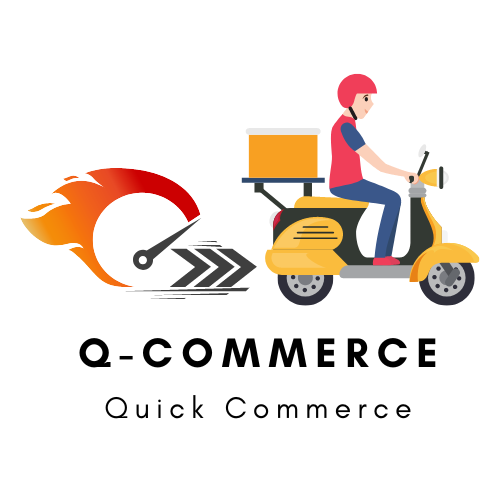What is Q Commerce or Quick Commerce?
Q-Commerce or ‘Quick Commerce‘ – is a convenient yet apt term to refer to a growing channel known as on-demand or rapid delivery. It refers to companies that deliver goods (typically groceries) in under an hour or as quickly as 10-15 minutes. The term is sometimes used interchangeably with “on-demand delivery” and “e-grocery.” However, it is e-commerce in a new, faster, local avatar.
Q-Commerce companies target neighborhoods of major cities through their network of micro-warehouses, commonly known as ‘cloud stores’ or ‘dark stores.’ It blends the best of traditional e-commerce with innovations in last-mile delivery with focus on narrow assortment and fast delivery.

Key Facts & Trends in Q-Commerce –
The Q-Commerce focus tends to be on the micro – small quantities of fewer goods. For example, think of a fast run to the neighborhood corner store to get a packet of chips or a box of coffee!
In Q-commerce, dark stores are typically used. These are fulfillment centers located in densely populated areas, so drivers can quickly pick up and deliver stock.
Online grocery shopping has grown significantly. As a result, the focus on delivering groceries fast and conveniently to customers’ homes or letting them pick them up on the way home from work has increased.
Marketers contend supermarkets are for macro purchases (e.g., weekly shopping). But, at the same time, q-commerce fills the gaps in between to replenish stocks.
Many quick commerce companies specialize in grocery delivery but will likely expand every day into ‘delivering anything’ including ‘groceries, shops, pharmacies, anything.’
According to multiple reports, on-demand delivery has low-profit margins. This is because the last mile of shipping typically is the most expensive part. Additionally, the average order value of customers is usually low. After all, it is the complete opposite of the ‘big shop.’ Nevertheless, the business model isn’t impossible to be profitable, especially when delivery fees, other opportunities like retail partnership and advertising are considered.
Many players are entering the Q-commerce market. It can get difficult to differentiate between multiple on-demand grocery companies. Hence, unique selling propositions like faster delivery time, enhanced Customer Experience, and almost instant gratification hold the key to success.
Q-commerce allows customers to purchase small quantities of goods almost instantly, wherever and whenever they want. It is common for Q-Commerce companies to deliver household goods to customers’ doors in less than half an hour, much faster in many cases. Q-commerce is there to complement a weekly shopping trip, rather than replace it, when you need a particular set of items, conveniently and quickly.
Several players have been delivering Food for many years, and Quick Commerce is a natural extension. As a result of shifting consumer behavior, it is now on an overdrive, and requests for delivery of other product categories are rapidly increasing
With Q-Commerce, consumers get a good choice of products, including their own private label brands and exclusive items, delivery is available 24/7. Backed by AI-enabled real-time inventory management and improved affordability through data and technology-driven pricing and economies of scale.
Among the features of Q Commerce are its technology-enabled rider community, its innovative logistics technology, and a wide range of platforms. Delivery riders have an average radius of fewer than 3 kilometers, so they can get to their customers quickly.
As bicycles and motorcycles can navigate traffic and routes faster, customers are guaranteed delivery within half an hour or less.
To offer customers the best assortment of products in their locality, Quick Commerce players partner with local businesses, like mom-and-pop shops, supermarkets, pharmacies, and flower shops.
Increase in urbanization has led to a surge in small or single-person households. This has led to consumers requesting delivery of small quantities of goods rather than purchasing many items in large quantities at a cheaper rate.
Quick commerce provided an opportunity to respond quickly and efficiently to the increased demand for delivery due to COVID-19 while supporting the social distancing process at the same time.
Q-commerce is the logical progression of e-commerce. Across the globe, lifestyles are changing, as are customer behaviors-Speed, Cost Effectiveness and Convenience are becoming increasingly important.
Since q-commerce has taken off, the fate of brick-and-mortar stores remains in limbo. However, many analysts believe that q-commerce is complementary, rather than replacing, brick and mortar stores.
Space Optimization: By maximizing every bit of their floorplan, dark stores don’t need to sacrifice valuable square footage to allow shoppers to browse aisles.
AI-backed Demand Forecasting – In Q-Commerce, companies use artificial intelligence and real-time demand sensing to ensure that popular products are always in stock.
Always-ON Shopping: Unlike brick-and-mortar retailers, dark stores are open 24/7, 365 days a year. It reflects the ‘always-on’ culture engendered by smartphones. For example, instead of lining up to pick up groceries from the local supermarket, shopping essentials with the push of a button. In addition, Q-commerce companies offer time-strapped customers a very enticing value proposition: Comfort!
 You will find more infographics at Statista
You will find more infographics at Statista

